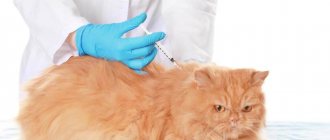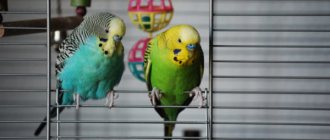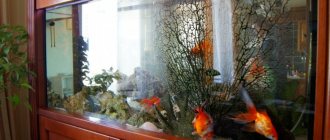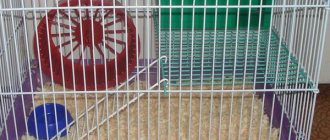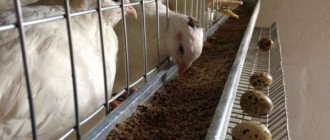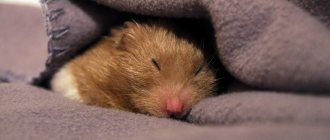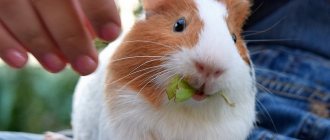How much does a Djungarian hamster cost?
| A country | Market price | Price in 300 store | Price in nursery |
| Russia | 50-200 rub. | 200-350 rub. | 300-500 rub. |
| Belarus | 1-3 white rub. | 3-5 bel. rub. | 4-7 bel. rub. |
| Ukraine | 5-50 gr. | 50 gr. | 100 gr. |
| Kazakhstan | 200-500 tenge. | 1000-2000 tenge. | 3000-4000 tenge. |
In Kazakhstan, hamsters are not highly valued: 100 tenge is 18 rubles, so a hamster will be sold on the market for less than 50 rubles. In Belarus, animals are also cheaper than in Russia: 1 Belarusian ruble is approximately 30 Russian rubles, the minimum price for a rodent on the poultry market. 50 hryvnia is the average price of dwarfs in Ukraine, approximately 116 rubles.
Good to know! It seems that in Russia prices for hamsters are the highest, especially in large cities. This is especially true for rare species of rodents: a Roborovsky hamster will cost at least 300 rubles, since these tiny animals are reluctant to breed in captivity and are not as common as pets.
Homemade hamster cage
The simplest and most practical material for a cage is a container. Think carefully about what the nest will look like. How many windows will there be?
Tools and materials
Before work, prepare everything you need:
- large plastic container;
- stationery knife;
- wire cutters;
- adhesive tape;
- cable ties;
- soldering iron;
- scissors;
- marker;
- metal grid.
Step-by-step instruction
- Draw a square door and windows with a marker.
- Apply adhesive tape along the outside edge to protect the plastic from chipping.
- Use a knife to cut out future windows.
- From the mesh, prepare squares two centimeters larger than the cut squares in the container.
- Using a marker, make marks for the cable ties on the plastic.
- Using a soldering iron, make holes according to the marks.
- Insert the mesh and secure with cable ties.
- Cut out the container lid from the mesh.
- Using a soldering iron, make holes for the zip ties.
- Secure the mesh with ties.
Cage tray
To make it easier to wash the tray, you can make it removable.
For this:
- Prepare another container 2-5 cm larger than the cage.
- Cut the pallet at least 6 cm high.
- Apply adhesive tape to the edges of the frame tray.
- Secure the joint between the pallet and the sides with 6-8 cm plates.
- Insert the frame into the pallet.
How to make a second floor in a hamster cage
If you are planning to make a two-story cage, then prepare a container of the same size.
Cut out the bottom and secure the cut edges. Make a mesh roof for the container.
The ground floor needs more windows for ventilation. You can completely replace one side wall with a grille. Secure the floors together with ties
You can connect the floors using a hamster tunnel.
Periodically it is necessary to do a general cleaning of the cage
Where to buy or how to make it yourself
How much does a finished house cost and where can I buy it? You can buy a home for a dwarf at almost any pet store. The average price is quite affordable: it all depends on the material. If you have the necessary skills, you can make a house for hamsters with your own hands according to instructions on the Internet.
- One of the simple options is a coconut house. The liquid is drained from the nut, then holes are carefully drilled of such a diameter that the hamster can freely crawl through them - at least 5 cm. If necessary, the coconut is washed from the inside and undergoes a grinding process. It may be difficult to remove the pulp. To make the process easier, the fruit should be placed in the freezer overnight - in the morning it will separate from the coconut peel itself. All that remains is to scrape it off with a chisel.
- To make a home from wood or plywood, you will need a piece 4 cm thick. Next, four boards are cut out and sanded - two 12 cm each and two 14 cm each. A 6 cm hole needs to be drilled in one of the smaller ones, and future windows in the long one. All parts are connected to each other.
You can make a labyrinth by hand from cardboard tubes soldered crosswise. The rodent will appreciate such an attraction. As for the stairs, plywood or wood is suitable for it. The main thing is proper polishing: the animal should not be scratched. Using available materials, it is quite possible to make pipes and labyrinths for the cage yourself. Toilet paper rolls, packaging wrappers, and shoe boxes will do. It all depends on your imagination!
All about the cage tray
Having dealt with the dimensions and rods, let's move on to the bottom of the cage. Usually in a pet store they offer it with a sliding tray. This option is not very suitable for your hamster, since he chooses one corner for the toilet. This makeshift toilet is usually located on the opposite side of the nest house. And often the stool ends up under the pull-out tray.
Another disadvantage of a pull-out tray is that it is not deep. Generally, a solid bottom is much deeper, which is more suitable for our runner. These hamsters love to throw the litter around and actively run over it, as a result of which it often flies out of the cage.
USEFUL TIPS ON HEALTHY NUTRITION
All products that you give to the animal must be fresh. Avoid frozen vegetables and fruits. They no longer contain useful substances. Observe the hamster's behavior. He can hide the fresh fruit and eat it when it is no longer fresh.
It is recommended to feed your pet twice a day, preferably in the morning and evening, at the same time. The regime is the key to good digestion of the animal. Monitor your pet's condition carefully. Is your hamster gaining weight quickly? Reduce your daily dose of food: overfeeding is harmful, as is undernutrition.
It is recommended to give juicier foods in the morning, and solid foods in the evening. Some experts recommend feeding the rodent 4-5 times a day, giving only as much food as it will eat at one time. If this is not possible, then collect leftover food from the cage every evening.
Hamsters have a habit of storing food for a rainy day. Firstly, food quickly spoils, and secondly, an unpleasant odor appears, food mixes with excrement, and becomes unsuitable for life. Stale food is dangerous for rodents.
Video: eating
Pregnant individuals
A pregnant pet should eat at least three times a day. The portion is doubled. Hay, nuts, and legumes are especially beneficial for pregnant rodents. Place hay directly into the feeder in small portions so that it does not mix with sawdust.
"Food block"
The apartment must have a feeding trough and drinking facilities.
As for the food bowl, a ceramic feeder is considered the most suitable option. Firstly, the hamster is unlikely to be able to turn it over, therefore, you will not need to clean up the spilled food, and secondly, such material is too tough for the fluffy, which means he will not be able to chew through it.
Now let's talk about the drinking bowl.
Inexperienced dzhungarika breeders use a small bowl as a water container, which is not very correct:
- Water can be spilled at the bottom of the rodent’s “apartment”, which will entail unscheduled cleaning.
- Evaporation of moisture, and as a result, the lack of water in the bowl at the moment when the hamster wants to quench his thirst.
Qualified experts recommend purchasing special drinking bowls that allow a small pet to quench its thirst without spilling water.
What else should be in the cage?
It is imperative to constantly monitor the presence of chalk in the cage, since it serves as a means of grinding down teeth. If you do not give it, then the animal will salivate due to its large incisors, the hair will stick together, and over time the hair will begin to fall out. If these symptoms occur, you should quickly seek help from a veterinarian.
The next, no less important items are a drinking bowl and a feeder made of heavy material, since the hamster loves to play and can use these things not for their intended purpose, but as a toy, constantly throwing it from corner to corner. It is also worth securing these items to the cage.
Training wheel. Since dzhungarikas are mobile, for a comfortable habitat they must run more than 10 km per day. The inside of the wheel must be solid and in no way lattice-like. If the surface is smooth, the animal’s paws will not slip, which will prevent injury. The optimal wheel diameter is 15-20 cm
To determine if the wheel size is right for your hamster, pay attention to how it runs. If the animal arches its back, this indicates that this toy is small for it, and it needs to be replaced with a larger one.
If this is not done, you can harm the spine, which will lead to bad consequences.
A bath with special sand intended for bathing.
As additional accessories, you can install a wooden suspended podium, stairs and tunnels. And by the way, you can make a tunnel with your own hands. The materials used to create this attraction can be cardboard, plastic bottles and wood. The design itself can be straight or branched; hamsters especially like devices with many passages, dead ends and windows. Depending on the location, the tunnels can be internal or external. In the first option, the pipes are located inside the animal’s permanent home, which gives it the opportunity to walk along narrow “paths” if desired. External tunnels are intended only for games outside the cage under the supervision of the owner.
If you decide to build a plastic tunnel yourself, then you will need electrical tape to hold the parts together, strong scissors and glue. The most labor-intensive material is wood; here you can’t do without a hammer, screwdriver, screwdriver, saw and jigsaw, but this design will last longer than others.
Where to put the cage?
When choosing the location of the cage, several criteria must be taken into account:
- If there are other animals in the house, the cage should be placed in a safe place so that it is impossible to get close to it.
- You should not place it in a draft, which can cause colds.
- The cage should not be placed on a windowsill, since, especially in summer, direct sunlight can lead to overheating of the animal's body.
- Close proximity to electrical and heating devices is not allowed.
You need to clean the inside of the cage every day, and carry out general cleaning every 2-4 weeks. Thorough cleaning involves changing the bedding and washing the tray, rods and accessories with warm water using baby detergents or special preparations.
It is very important to return items exactly to the places where they were
Why does a hamster constantly chew on its cage?
What may be causing your hamster to constantly chew on its cage:
The need to constantly grind down the teeth Lack of special devices in the cage (mineral stone or chalk) Lack of entertainment Can provoke unwanted behavior of the animal Insufficient attention By “gnawing” the cage, the hamster tries to convey to the owner that he lacks communication Crowded space If there is insufficient space, the hamster regularly chews on the cage, trying to explain to his owner about the need to expand the area of his “possession”
If you have fulfilled all the requirements, and your pet continues to chew on the cage, you need to lubricate the bars by mixing lemon juice with olive oil. This folk remedy will not harm your animal at all and will help rid him of this bad habit.
If you want to find out how much your pet runs during the night, you can install a special device that reads the run time. By the way, there are cages on sale in which this device is already built-in.
To understand whether your pet is comfortable in a cage, you can observe its behavior. Under suitable conditions, the hamster is active and playful, especially at night. Choose your cage wisely, and your pet will thank you for it!
What do dungarian hamsters eat?
Although Djungarians are small hamsters, they love to eat. Moreover, like all steppe rodents, they stock up, dragging the remains of grains and fruits to secluded places in the cage.
Photo: pixabay.com: UGC
Will information about what Djungarians eat help you create a menu for them? The easiest option for owners is to buy a ready-made mixture at a pet store. In it, grains are selected so that the animal’s nutrition is balanced and dietary.
But many representatives of this species are capricious. Therefore, owners will have to take a closer look at what products their pet prefers, and periodically pamper him with such treats.
You need to give your hamster:
- Cereals: oats, corn, barley, peas, seeds.
- Nuts: Greek, peanuts, etc.
- Fresh vegetables: cucumber, carrots, milk corn grains, lettuce.
- Fruits: apple, pear, berries.
- Protein foods: low-fat cottage cheese, a piece of unsalted lard, boiled chicken.
Hamsters are prone to allergies and eczema, so watch their diet. Remove those foods that cause hair loss, flaky skin, and stomach upset.
Foods high in fat (sour cream, hard cheese, cream and butter), smoked meats and any sausages are detrimental to the Djungarian’s delicate stomach. Potatoes, onions, mushrooms, cabbage, citrus fruits, as well as confectionery, honey, sugar and chocolate will cause health problems.
Photo: pixabay.com: UGC
To maintain good physical shape, offer rodents special grain sticks. This fortified food provides dungarians not only with energy, but also with a silky, soft coat, sharp teeth and claws.
To grind down their teeth, they will need a special chalk or mineral stone. Instead, you can offer the animal a birch (in no case coniferous) block.
Care
Frequent illnesses
The most common problem with Djungarian hamsters is injuries that the animal can receive when falling. When injured, you may notice that the hamster's paw is twisted or turned at an unnatural angle. From pain, the animal can fall into a state of shock: it is motionless and does not react to what is happening. An injury is a reason to take your hamster to the vet as soon as possible. Treatment depends on the condition of the animal and the severity of the injury.
Susceptible to respiratory viral infections. Infection is indicated by:
- decreased activity;
- sneeze;
- loss of appetite.
There is no special treatment for viral diseases in Djungarian hamsters. It is recommended to provide your pet with vitamin supplements and high-quality food to strengthen his body’s immune defense and speed up recovery.
Conjunctivitis
If your hamster cannot open his eyes and there is a small amount of pus on his eyelids, he may have developed conjunctivitis. It is recommended to treat conjunctivitis by washing the animal’s eyes with a weak saline solution. In order not to make a mistake in the concentration, you can buy saline solution with a sodium chloride concentration of 0.9% at the pharmacy.
Cataract
Cloudiness of the pupil indicates cataracts. This disease usually develops in older individuals. It is impossible to cure cataracts.
Long teeth
Refusal to eat may indicate a dental injury or that too long teeth are preventing you from eating. In such cases, the teeth should be straightened by contacting a veterinarian. To prevent excessive growth of incisors, you should constantly keep a chalk stone in the cage.
Dermatophytosis
Peeling skin and hair loss are a sign of eczema or dermatophytosis. Problems with the skin indicate either stress or the presence of an allergen in the cell. Treatment of eczema and dermatophytosis is carried out by a veterinarian.
Parasites
If your hamster is constantly itching, restless, and has red dots visible on its skin, it most likely has parasites (lice or fleas). On sale you can find many products designed to combat skin parasites in rodents. A veterinarian will help you choose the safest one for your animal.
Refusal to eat, diarrhea, and loud bowel movements are symptoms of an intestinal infection. They can be cured with antibiotics.
How to properly care?
It is enough to provide him with everything he needs (a spacious cage, food, a drinking bowl with fresh water). There are some subtleties that will allow you to create optimal conditions for the animal. In order for the pet to quickly get used to the owner, it is recommended:
- talk to the animal in a quiet, calm voice;
- pick up the hamster delicately and gently, supporting it under the front paws;
- before touching the animal, give it the opportunity to sniff your hand: this way the animal will quickly get used to the owner’s smell.
It is important to clean the cage regularly. This should be done once every 7-10 days
The hamster is placed in a small carrier cage or cardboard box with holes for ventilation. The old filler is removed and replaced with a new one, leaving a small amount (to make the animal feel more comfortable). Once every 4 weeks it is necessary to wash the cage or aquarium with warm water and laundry soap.
How not to care
To avoid harming your hamster, you should:
- bathe your pet in soap and water. The hamster can handle cleaning its fur on its own. You can buy special sand for him for bathing guinea pigs. Sand is poured into the bathing suit and placed in the cage. After some time, the hamster begins to wallow in the sand and clean its skin;
- buy a “comrade”. Hamsters do not tolerate rivals and defend their territory. They only need a partner for reproduction; the rest of the time, dzhungarikas feel great alone. If the need to house two hamsters in one cage is great, you must first divide the cage into two halves using a partition. The partition can be removed only when the animals get used to each other and do not show signs of aggression;
- leave the hamster on a high surface. Rodents are lowland animals and do not understand what height is and its dangers. Dzungarik may fall and be seriously injured and even die.
In order for your hamster to quickly get used to it and trust its owners, you should not:
- make sudden movements near the animal;
- scream near the cage, play loud music;
- pick up a sleeping or recently awakened animal. This can frighten the hamster so much that it bites the owner, which is quite painful;
- roughly take an animal by the withers to lift it.
Where to put a cage with a rodent
The hamster cage can be placed in any convenient place in the house, with the exception of some potentially dangerous areas.
You cannot place a house with a pet near heating appliances, in drafts or on the floor. It is also not recommended to place the structure next to furniture, curtains and a wall with wallpaper. A rodent, due to its natural instincts, can gnaw everything that comes within its access zone.
Hamsters are quite shy animals and cannot tolerate loud sounds, so it is also not recommended to place a cage with a pet near a TV, musical equipment and other household appliances that make a lot of noise. Buying a cage for a hamster is not difficult. Modern pet stores have a large selection of designs for pet rodents of different breeds and sizes. The main thing is to take into account all the listed criteria when choosing and create the correct arrangement of the home so that the pet can be active, beneficial for its health.
How to accommodate?
Only some breeds of hamsters can be housed in pairs
Which breed of hamster should you choose? Spotted hamsters are considered more active and irritable. Naturally colored animals are healthier. They are less susceptible to various diseases. It is worth considering that any animal can live a long time, but only with proper care. Therefore, the question of which hamster to choose is secondary.
It is advisable to have one hamster, as adults often fight with each other. If you are going to breed these rodents, then the male and female should be kept in separate cages before and after mating. Only dwarf hamsters from the same litter can be housed together.
In order for your hamster to live a long and happy life, he needs to be provided with appropriate care and optimal living conditions.
It is very important to choose the right cage for your hamster. It should be spacious and not stuffy
Most often you have to buy it as the rodent grows. In addition, your hamster will need a variety of equipment and toys to satisfy its natural need to run.
The bottom of the cage must be covered with a special filler, which must be changed regularly (depending on the size of the pet). The cage itself must be washed periodically, temporarily releasing the hamster “free” in a special walking ball.
2014-10-08
All articles
Preparing for the arrival of a hamster in the house
Before buying a Djungarian hamster, it will be useful to know what types of rodents there are. Thanks to the variety of colors, each person can choose a pet to their liking. The most common coat color is wild or standard. These hamsters have gray-brown fur.
Other popular colors are bred artificially:
- pearl is a white Djungarian hamster;
- sapphire – blue-gray fur;
- mandarin – light brown fur with reddish tint;
- brown;
- black;
- chocolate.
Reference. There are no albino Djungarian hamsters. The breed contains individuals with light beige and light ash fur. Animals with this coloring appear almost white.
Djungarian hamsters - animal features
Before you get a Djungarian hamster at home, it is recommended that you read the description of its lifestyle in the wild. Then it will be easier to organize suitable conditions and provide care. Information you need to know:
- Representatives of this species are nocturnal. They sleep almost all day and are active at night.
- With good care, a hamster at home will live for about 3 years.
- Djungarian hamsters are loners. They do not tolerate proximity to their own kind. Rodents that find themselves in the same territory fight. This applies not only to same-sex individuals, but also to opposite-sex individuals.
- In Djungarian hamsters, the incisors grow constantly. Therefore, the animal must grind them down.
- Djungarik may die from fright or overheating. It is important to provide him with good care - he is a very sensitive animal.
- Hamsters are fertile. A female can bring up to 6 litters in a year.
- Djungarians are easy to tame. They have a calmer disposition than Syrian hamsters.
Pros and cons of content
Keeping Djungarian hamsters has both advantages and disadvantages:
| pros | Minuses |
| The rodent is small, so it does not take up much space. He constantly sits in a cage, does not run around the apartment, and does not damage property. | Short lifespan: dzhungarikas live 2.5-3 years. |
| Affordable price. A Djungarian hamster costs 150-300 rubles (depending on the region). Anyone can buy it. | The pet is active at night. During the day he leaves the house several times to eat. |
| Even a school-age child can show care and care for a hamster. | Unpleasant smell. If well cared for, hamsters do not smell. The problem will not arise if you regularly clean the cage. |
| Unpretentiousness in nutrition. Djungarian hamsters eat little. For a month they will only need half a package of cereal mixture and some vegetables. | Some Djungarian hamsters can bite, although they are not aggressive. Teeth are used if the animal is scared. |
| Positive emotions. Tiny hamsters are very funny and fun to watch. | Noise. At night, a rustling sound is constantly heard - the pet is digging the litter and running in a wheel. |
How to choose a cage for a hamster?
When choosing a suitable home, you should focus on the type of rodent.
Cage for Djungarian hamster. A breed that needs space for its active activity. It is recommended to purchase a wheel and other entertainment accessories. Not only the size of the cage for a hamster should be suitable, but also its reliability, so the lock should not open easily, and the distance between the bars should not be large. A high-quality ventilation system is important.
Syrian hamster cage. These rodents are large, so you shouldn’t skimp on space when choosing a home for them. The common cage size of 35x20 cm is not for them
Please note that the distance between the rods does not exceed 5 mm.
https://youtube.com/watch?v=XJDG_risl1g%250D
Features of keeping hamsters at home
There is nothing complicated in caring for and maintaining Djungarian hamsters at home, but you need to know some nuances. For example, that these animals are very sensitive to microclimate and stress. In addition, errors in feeding and care can lead to illness or death of the pet.
Djungarian hamsters - microclimate
Djungarian hamsters feel comfortable at temperatures from +18 to +26 degrees. It is not recommended to keep them on an uninsulated loggia or place the cage near a heating radiator. A suitable humidity level is 55-65%.
Rodents are afraid of dampness. In such conditions, animals often suffer from colds and become more vulnerable to bacterial and viral infections.
Another enemy of the Djungarian hamster’s health is draft. When caring for a rodent, the level of lighting should also be taken into account. Too bright light is irritating. In the wild, hamsters emerge from their burrows only in the dark. Therefore, experts recommend slightly shading the cage for the Djungarian hamster so that the sun's rays do not get inside.
Cage selection and equipment
To make caring for your rodent easier, you need to choose the right cage for it. The most suitable option is a metal lattice structure. Its main advantage is good ventilation.
Some people keep Djungarian hamsters in aquariums. If the choice falls on such a home, then the animal will be forced to constantly breathe fumes of ammonia and hydrogen sulfide. These substances are released into the air when rodent feces decompose.
Cage requirements:
- minimum size – 30x50 cm;
- retractable tray for easy care of the hamster;
- tightly closing door at the bottom of the structure;
- The width between the rods is no more than 0.8 cm.
There may be several tiers, then the dzhungarik will have more free space to move. The floors are connected to each other by stable, flat stairs or tunnels.
When caring for Djungarian hamsters, it is important to pay attention to hygiene. You need to choose a good filler that quickly absorbs moisture and masks the unpleasant odor.
Newspapers, napkins, paper are not the most suitable option.
Experienced breeders recommend using the following types of fillers as bedding:
- corn;
- cellulose;
- pressed sawdust.
Those who prefer wood filler need to study its composition. It should not contain coniferous sawdust - spruce, pine. This wood contains a lot of essential oils, which often cause allergies in hamsters.
Caring for a Djungarian hamster involves ensuring comfort inside the cage. The animal will need equipment:
- 2 feeders – for grain and wet food;
- drinking bowl;
- running wheel;
- holiday house;
- toilet.
This is the required minimum. If space allows, you can place a small piece of driftwood on the floor and secure the branches so that the Djungarian hamster can climb on them. Some owners note that their pets love to climb into a hanging hammock. You can sew it yourself or buy it ready-made at a pet store.
The Djungarian hamster's home needs to be kept in order. The filler is replaced regularly - every 5-7 days. If this is not done, an unpleasant odor will appear. All equipment is washed and scalded with boiling water. The tray is treated with soda solution.
Djungarian hamsters - feeding
High-quality care for the jungarik includes providing the animal with adequate nutrition. The basis of the diet is a grain mixture. Pet stores sell special food for Djungarian hamsters, which includes:
- wheat;
- millet;
- oats;
- buckwheat;
- peas;
- peanut;
- Walnut;
- raisin;
- sunflower seeds;
- corn.
The richer the composition, the better. In addition to the grain mixture, hamsters can be given vegetables - carrots, zucchini, cucumber, cauliflower, broccoli. Apples, pears, and sour berries are allowed as fruits.
The diet must include greens - alfalfa, dandelion and plantain leaves, lawn grass. In winter, all this can be replaced with dry herbal granules.
Twice a week, Djungarian hamsters are given a little low-fat cottage cheese, boiled chicken breast and egg yolk.
List of prohibited products:
- citrus fruit;
- Red beetroot;
- cheese;
- fish;
- any salty and sweet food;
- bread, cookies;
- sour cream;
- butter;
- honey;
- sausages;
- smoked meat;
- onion;
- potatoes in any form.
Branches of fruit trees or bushes are left in the cage. Dzungarik grinds down his constantly growing teeth when he gnaws on such a delicacy.
Breeding
Djungarian hamsters cannot be kept together. Both same-sex and opposite-sex individuals are housed separately from each other - either in different cages, or in one large one, separated by a partition. To organize mating, it is necessary to place the female with the male.
Mating is possible on certain days. You need to wait until the female goes into heat. In Djungarian hamsters it occurs every 4 days. At this time, the female is loyal to the male and allows him to get closer to her.
Attention! Puberty in Djungarians occurs at one month of age, but this is not the right time for the first mating. The female is not yet ready for pregnancy and childbirth. It is better to wait until she is 3-4 months old.
After mating, the hamsters are seated. The absence of another heat indicates pregnancy, which lasts 21 days. During this period, the expectant mother needs good care and proper nutrition. She should not be disturbed, as any stress can harm her health.
There are 4-6 babies in a Djungarian hamster litter. They are born blind, deaf and completely bald. Caring for newborns is not required - the female does everything herself.
Babies should not be picked up until their eyes open. This occurs 2 weeks after birth. By the age of one month, hamsters become adults and are removed from their mother.
Kinds
Materials
Pet stores offer several options for hamster cages.
Made of metal rods. A good ventilated home in which the rodent feels quite comfortable. The inconvenience is that the noise the hamster makes can be clearly heard through the bars, and dirt always forms around. Filler and debris easily penetrate through the bars. The grill itself should be made of high-quality solid metal.
It is recommended to buy cages in which the second floor is made of plastic and reinforced with high quality. Try to avoid wooden elements in the cage, as wood absorbs unpleasant odors and also becomes a favorite material for grinding down the rodent's incisors.
Designs and sizes
The length of the cage for one dwarf hamster should be at least 50 cm. This is even longer than for a Syrian hamster. And although the Syrian is larger in size than the Djungarian, the miniature pet still has to run a greater distance per day, so it needs a more spacious cage. If the cage is purchased without additional equipment, then do not forget that the area will be reduced due to the established mandatory attributes.
Give preference to a cage with horizontal bars - rodents like this shape more, and it is much easier to attach additional devices to a horizontal grid for a comfortable life for a rodent.
If the distance between the rods is greater, the hamster will definitely try to escape. And even if the cage contains a fairly well-fed individual, this factor does not deprive it of its plasticity.
However, if the owner keeps several hamsters at once and plans to breed them, then it is better to opt for a large cage. It is worth mentioning separately about the day of the dwelling. It can be with a retractable mechanism or high. A retractable bottom is much more convenient in terms of cleaning, but a cage with a high bottom is suitable for breeders, since the high sides will prevent curious little hamsters from falling out of the cage.
Pros and cons of breeding dzhungarikas
Breeding Djungarian hamsters is not that profitable. The retail price of a young individual rarely exceeds 200 rubles, and breeders sell rodents to stores in bulk for a lower price. It turns out that the owner gets about 100 rubles from each hamster, and 500-600 rubles from one litter. At the same time, he spends much more on the maintenance and care of his pets - he invests money in cages, food, supplies, and veterinary care.
There are other difficulties in breeding dzhungariks. During breeding, the female and her children need complete rest. It is quite difficult to provide this if the rodents were purchased for children.
Another problem that Djungarian hamster breeders face is finding a new home for their growing rodents. A lot of babies are born, so it can be very difficult to place them in good hands.
Breeding Djungarian hamsters at home also brings little benefit. Females live much longer when they do not waste their body’s energy and resources on bearing offspring and giving birth. Animals do not suffer at all from not reproducing.
Obviously, the reproduction of Djungarian hamsters is a fascinating process. But it requires a lot of time, effort and material costs from the rodent owner.
Selection of bedding and nesting material
Cleanliness in the cage is the key to your hamster’s health and your comfort. To ensure that cleaning is not a difficult, time-consuming task, you need to choose bedding that will suit you and your pet as much as possible. Some owners put paper, cardboard, newspapers, and napkins on the bottom of the cage. This is not the best option both in terms of hygiene and safety for the animal. The paints and chemicals used to treat paper often cause pet poisoning. And if a hamster eats a napkin, it can result in serious digestive problems.
The best bedding options for a hamster are:
- wood granulate;
- sawdust;
- quality hay .
Wood granules make cleaning simple and easy, they absorb liquids and odors perfectly, but for small hamsters and babies it can be inconvenient - small paws will get stuck between the granules.
Sawdust is an excellent filler, from which a hamster can also make a bed for himself in the house. Sawdust does not injure the limbs, it is comfortable to run on it, it absorbs liquid well, but in fluffy hamsters, pieces of wood often get stuck in the fur, so you will have to regularly care for your pet’s fur coat.
Hay is used not only as food, but also as an environmentally friendly filler for the cage. However, you should choose only high-quality hay without straw and sticks, which can injure rodents’ limbs. Hay will also serve as excellent nesting material.
By the way, about the nest or bed. At the pet store you can buy special material for making a mink - flax fiber. This is an environmentally friendly, soft, pleasant material, safe for pets and perfectly retains heat, which is especially important in the cold season. If you want to buy it, contact the Masterzoo store.
How to set up a hamster cage?
To create a comfortable environment for the animal, it is recommended to choose the necessary accessories for it. Tips on what should be in a hamster's cage:
- Feeder
. It is recommended to choose a ceramic container with a stable bottom. It is especially necessary for Syrian hamsters. - Toys
. You can use not only purchased options, but also improvised means. For example, hamsters can have fun with cardboard toilet paper rolls. You can buy a plastic ball that your pet will roll around the cage. - Mineral stone
. Rodents love to sharpen their teeth, so this element is important. It will become a source of useful minerals. Some stones include various additives: dried fruits, probiotics and vitamins. - Other
. In the cage you can place a ladder, a hammock where the pet can rest, and so on.
https://youtube.com/watch?v=H9X8hS2pVCY%250D
Hamster drinking bowl
A water container is a must-have item in a rodent's home, so when thinking about what your hamster needs in its cage, it should be added to your list. You should not use a regular saucer or bowl, as the animal will easily turn them over. It is recommended to give preference to a special drinker, for example, vacuum, nipple, and so on. They fix it on the outside, bringing a spout or tube for drinking liquid inside the cell.
Hamster wheel
These rodents are active, and to ensure that they spend their energy properly, it is recommended to buy a wheel for them. Not only the rodent cage, but also this accessory must be safe. Choose solid products that do not slip inside and have transverse projections. If you want to buy a mesh structure, then give preference to options made from small sections. A good choice for a hamster cage is a wooden wheel. The size must fit the pet:
- for large breeds a diameter of 19-30 cm is suitable;
- for small ones – 14-17 cm.
Hamster toilet
When choosing this element for a hamster cage, you need to consider the following points:
the toilet must match the size of the pet; choose triangular or square shaped products; collapsible structures are practical; the product must be made of high-quality plastic; It is important that the structure is stable, for example, it can be secured with hooks.
Hamster house
For proper rest, it is recommended to install a house in the cage, which should be safe and stable. The size of the home is directly related to the size of the rodent. It is not recommended to make a house for a hamster out of cardboard, since the structure will be quickly destroyed by the pet's teeth. The range includes options from different materials:
Plastic house. The most popular option, which is durable and reliable. However, it is not ventilated enough. To make the houses, we use high-quality plastic that is easy to clean. The designs come in various shapes.
Wooden house. Building from environmentally friendly material is a good choice. Rodents can climb onto the roof because the surface is rough. Most wooden houses look like a dog kennel.
Ceramic house. Such buildings can be considered a novelty. Ceramics are safe and retain heat well. Moreover, the price for such houses is higher than for options made of plastic and wood.
It is important to consider the fragility of the structure, which can break. The houses are presented in a wide range, for example, there are options in the form of vegetables or cheese.
Hamster maze
In nature, rodents regularly dig holes, improving and improving them. At home, they can be replaced by a hamster cage with pipes, but tunnels can be easily purchased separately. Important nuances of choice include the following:
Pay attention to the diameter, so the rodent, being inside, should feel the walls. The tubes can be made of different materials, which will provide the animal with additional research opportunities. When choosing a labyrinth for a hamster cage, be sure to consider its safety, this applies to both the material and the design itself. Pay attention to the strength and quality of the connections so that the product will last for many years.
Additional accessories
The list of optional elements that can be collected in the animal’s “dowry” includes:
- swing;
- stairs;
- hammocks;
- labyrinths;
- toys.
All these accessories will bring additional joy to your pet, but may well be classified as excess.
Important! When choosing additional accessories, you need to pay attention to their quality. There should be no cracks or crevices on the surface of the toys that the animal’s paws could get into.
Hamsters are active and unpretentious animals that are ideal for keeping at home. And in order for them to please their owners with funny pranks longer, they need a spacious cage with all the necessary elements.
